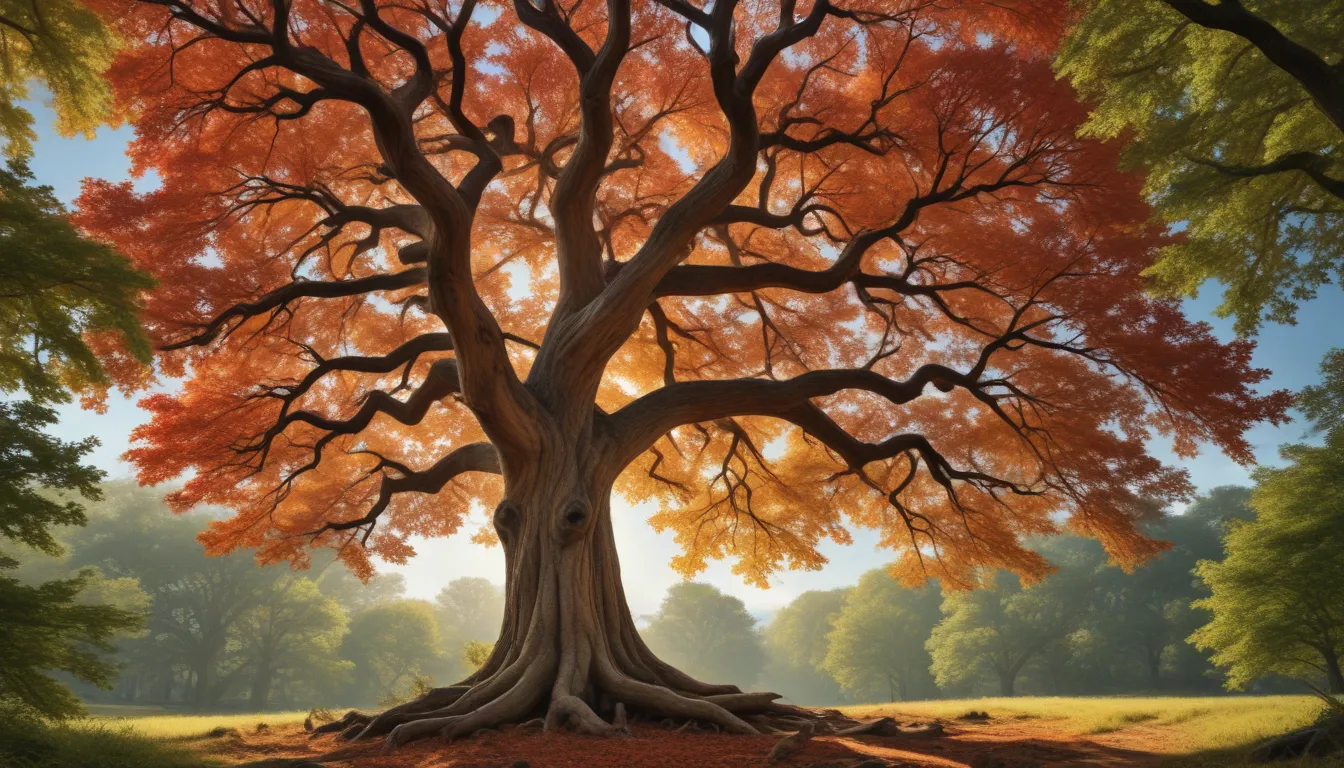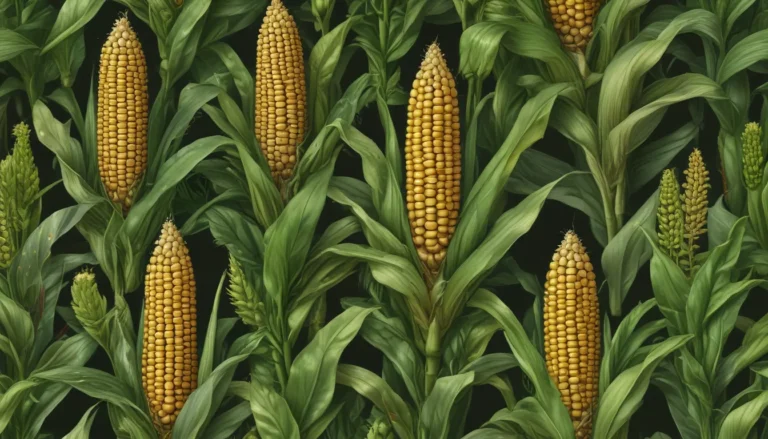The pictures we use in our articles might not show exactly what the words say. We choose these pictures to make you interested in reading more. The pictures work together with the words but don’t take their place. The words still tell you the important facts.
Welcome to the enchanting world of red oak trees – towering giants that stand as symbols of resilience, beauty, and enduring significance in nature. In this comprehensive guide, we will delve into the fascinating realm of red oak trees, uncovering 20 intriguing facts that showcase their unique characteristics and ecological importance. Whether you're a nature enthusiast, a budding arborist, or simply someone who appreciates the wonders of the natural world, this exploration of red oak trees is sure to leave you with a newfound appreciation for these remarkable giants of the forest.
Key Takeaways:
- Red oak trees are towering giants with distinctive leaves, providing essential habitat and food for wildlife. They symbolize resilience, beauty, and enduring significance in nature, captivating the imagination of all who encounter them.
- Red oak trees play a vital role in supporting biodiversity, combating climate change, and enriching landscapes with their ornamental beauty. Their deep roots and enduring presence embody strength, endurance, and the wonders of the natural world.
Red Oak Trees: Majestic Giants of the Forest
Red oak trees are known for their towering presence, reaching heights of up to 75-90 feet and boasting a canopy spread of 45-50 feet. Their grandeur and commanding presence make them a beloved sight in forests and urban landscapes alike. These majestic giants captivate all who behold them with their impressive stature and vibrant foliage.
The Enduring Legacy of Red Oak Trees
Red oak trees have an impressive lifespan, often living for 200-500 years in optimal conditions. Their enduring presence serves as a testament to their resilience and adaptability in various environments. These trees stand as silent witnesses to the passage of time, embodying strength, endurance, and the timeless beauty of nature.
Distinctive Features of Red Oak Leaves
The leaves of red oak trees are characterized by their pointed lobes and bristle-tipped edges, adding to their visual allure. During the fall season, these leaves transform into a vibrant display of red, russet, and bronze hues, creating a breathtaking spectacle. The distinctive foliage of red oak trees adds a touch of elegance to the autumn landscape.
Supporting Wildlife: Essential Habitat and Food Source
Red oak trees play a crucial role in supporting diverse ecosystems, providing shelter and sustenance for numerous wildlife species. Their acorns serve as a vital food source for birds, mammals, and insects, contributing to the intricate web of life in forests. These trees are not only majestic in appearance but also essential for maintaining biodiversity in their habitats.
The Value of Red Oak Wood
The wood of red oak trees is prized for its strength, durability, and attractive grain patterns, making it a sought-after material for furniture, flooring, and architectural applications. Its versatility and aesthetic appeal have cemented its status as a staple in woodworking and construction. The timber of red oak trees is highly valued for its quality and versatility in various industries.
Adaptability to Varied Soil Conditions
Red oak trees exhibit remarkable adaptability, thriving in a range of soil conditions, including acidic, loamy, and well-drained soils. This resilience enables them to flourish across diverse landscapes, from uplands to lowlands. The ability of red oak trees to adapt to different soil types underscores their versatility and resilience in various environments.
Autumn Splendor: Integral to Fall Landscapes
During the autumn season, red oak trees adorn the scenery with their dazzling foliage, adding a rich tapestry of color to forests and parks. Their vibrant leaves create a picturesque backdrop, drawing admirers from far and wide. The stunning display of colors exhibited by red oak trees enhances the beauty of fall landscapes and captivates the hearts of onlookers.
A Member of the Beech Family
Red oak trees are members of the beech family, Fagaceae, which encompasses a diverse array of trees known for their hardwood timber and ecological significance. This botanical association highlights their close kinship with other esteemed tree species, showcasing their importance in the ecosystem. The familial ties of red oak trees underscore their role in the intricate web of life in forests.
Symbolic Significance in Native American Culture
In Native American traditions, red oak trees hold symbolic significance, representing strength, endurance, and wisdom. They are revered for their role in providing resources and serving as a source of inspiration in tribal folklore and rituals. The cultural significance of red oak trees in indigenous practices reflects their deep-rooted connection to human history and spirituality.
Contribution to Biodiversity Conservation
Red oak trees contribute to the preservation of biodiversity by fostering a rich habitat for a multitude of organisms, including fungi, lichens, and invertebrates. Their presence enhances the ecological balance and resilience of forest ecosystems, supporting the intricate web of life. The role of red oak trees in biodiversity conservation highlights their vital importance in maintaining healthy ecosystems.
Vigilance Against Pests and Diseases
While resilient, red oak trees are susceptible to pests such as gypsy moths and oak wilt disease, which can pose significant threats to their health. Vigilant monitoring and conservation efforts are crucial in safeguarding these iconic trees from potential harm. The importance of pest management and disease prevention in protecting red oak trees underscores the need for proactive conservation measures.
Carbon Sequestration and Climate Mitigation
Red oak trees actively sequester carbon dioxide from the atmosphere, playing a pivotal role in mitigating climate change. Their capacity to store carbon underscores their ecological importance in combating environmental challenges. The role of red oak trees in carbon sequestration highlights their contribution to mitigating the effects of climate change and enhancing environmental sustainability.
Resilient Roots: Anchors in the Earth
The root systems of red oak trees delve deep into the earth, anchoring them securely and enabling efficient nutrient uptake and water absorption. This robust root structure contributes to their resilience and longevity, providing stability and support for the towering giants. The deep roots of red oak trees serve as anchors in the earth, sustaining their growth and vitality in various environmental conditions.
Ornamental Value: Beauty Beyond Utility
Beyond their ecological and commercial significance, red oak trees are cherished for their ornamental beauty, gracing landscapes with their stately presence and enriching the visual appeal of parks, gardens, and natural settings. The aesthetic charm of red oak trees adds a touch of elegance to outdoor spaces, enhancing the overall ambiance and beauty of the surroundings.
Diverse Habitats: Thriving Across Landscapes
From eastern Canada to the southeastern United States, red oak trees thrive in a range of habitats, including mixed hardwood forests, upland slopes, and bottomlands. Their adaptability to varied environments underscores their ecological versatility and widespread distribution. The ability of red oak trees to thrive in diverse habitats showcases their resilience and adaptability in different landscapes.
Medicinal Traditions: Healing Properties of Red Oak
In indigenous cultures, various parts of the red oak tree have been utilized for medicinal purposes, with the bark and acorns serving as traditional remedies for ailments. This historical connection reflects the deep-rooted relationship between humans and these revered trees, highlighting their importance in traditional healing practices. The medicinal properties of red oak trees have been recognized and utilized by indigenous communities for generations, showcasing their value beyond their ecological significance.
Soil Enrichment: Nurturing the Earth
The leaf litter and organic matter produced by red oak trees contribute to soil enrichment, fostering a conducive environment for diverse flora and fauna. Their role in enhancing soil health underscores their impact on the broader ecosystem, supporting the growth and vitality of plant life. The contribution of red oak trees to soil enrichment highlights their role in nurturing the earth and promoting ecosystem health.
Bark Patterns: Nature’s Textured Canvas
Red oak trees are distinguished by their rugged, deeply furrowed bark, which adds to their visual allure and serves as a protective outer layer. The intricate patterns of their bark stand as a testament to their resilience and natural beauty, showcasing nature's textured canvas. The distinctive bark patterns of red oak trees add a touch of character and charm to their majestic presence in the landscape.
Artistic and Literary Inspiration: A Source of Creativity
Throughout history, red oak trees have been celebrated in art, literature, and folklore, symbolizing strength, endurance, and the enduring beauty of nature. Their profound influence on cultural expressions highlights their timeless significance and enduring legacy in human creativity. The inspirational power of red oak trees has sparked artistic and literary works that pay tribute to their majestic presence and symbolic importance in nature.
Resilience and Renewal: Symbols of Strength
Red oak trees embody the enduring spirit of resilience and renewal, weathering the changing seasons and standing as enduring symbols of strength and vitality in the natural world. Their timeless presence serves as an enduring source of inspiration and admiration, inspiring awe and reverence in all who encounter them. The resilience and renewal exhibited by red oak trees symbolize the enduring power of nature and the beauty of life's cyclical rhythms.
Conclusion
In conclusion, the red oak tree is a magnificent species that holds significant ecological, aesthetic, and commercial value. Its striking appearance, resilience, and adaptability make it a cherished component of forests, parks, and landscapes. With a lifespan spanning centuries, the red oak tree symbolizes strength, endurance, and natural beauty. By understanding these 20 fascinating facts about red oak trees, individuals can develop a deeper appreciation for these majestic specimens and the vital role they play in our environment.
FAQs
What are the distinctive features of red oak trees?
Red oak trees are characterized by their deeply-lobed, bristle-tipped leaves, dark gray, deeply furrowed bark, and acorns with a fringed cap.
How long does it take for a red oak tree to reach maturity?
Red oak trees typically take around 20 to 30 years to reach reproductive maturity, with optimal acorn production occurring between 50 and 80 years of age.
Explore, Learn, and Discover
Our commitment to delivering trustworthy and engaging content is at the heart of what we do. Each fact on our site is contributed by real users like you, bringing a wealth of diverse insights and information. To ensure the highest standards of accuracy and reliability, our dedicated editors meticulously review each submission. This process guarantees that the facts we share are not only fascinating but also credible. Trust in our commitment to quality and authenticity as you explore and learn with us.






